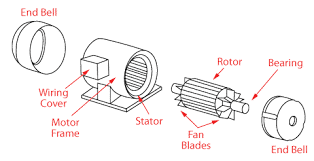An induction motor always runs at speeds just below its synchronous speed. At no load, the speed is closest to its synchronous speed. This running speed reduces further when loaded towards its full load capacity, from about 5% for a moderately rated machine to just more than 5% for a smaller rated machine. The decreased speed of the motor with an increase in loading is insignificant, and an induction motor can be called an almost constant-speed motor.

The induction motor is almost a constant-speed motor. The speed of the rotor flux slightly lags the stator flux, and a relative speed exists between the stator and the rotor. The difference in the speed of the motor changes slightly with the increase of loading on the motor. At no s called the slip speed. At no load, the slip is very low, and the torque produced by the motor meets the no-load losses and frictional losses. Hence, at no load, the motor rotates almost at the synchronous speed( Ns= 120f/P).
When the load increases, the motor tries to deliver the load to a mechanical load, and, in this process, the speed of the motor decreases. The decreased speed of the motor causes increased slip, and the motor draws a large rotor current to deliver the torque, which tends to bring the speed of the motor to its original speed.
The slip of the induction motor varies between 3 and 5 % of the synchronous speed. When the load on the induction is increased, the slip decreases within its specified slip range.
Thus, an induction motor can be called a constant-speed motor.